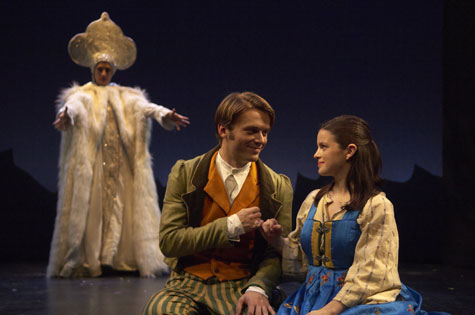
BREAKING THE SPELL Hans Christian Andersen’s Snow Queen at Portland Stage. |
This week, we look at another theatrical alternative to the Dickens ghosts. Portland Stage Company, which usually stages its own beloved Christmas Carol, mounts a different wintery classic this year: Hans Christian Andersen's epic struggle of warmth against chill, The Snow Queen. Anita Stewart directs a colorful and lively ensemble production of the fairy tale in which young Gerda (Lauren Orkus) journeys far, and mostly barefoot, to save her friend Kai (Ian Carlsen) from literal and figurative coldness.
Andersen's story starts with a goblin-like inventor (Tom Ford, maniacally) who creates a mirror that distorts reality, reflecting only the bad and ugly in good, beautiful people. When the mirror is accidentally shattered, its shards blow all over the place, splintering people's hearts and eyes and freezing them up inside. One piece ends up in the eye of Kai, the neighbor and best friend of Gerda, and he turns distant, calculating, and mean. When the snow flies and a glacially lovely mystery lady in white furs (Patricia Buckley, elegantly) comes through town, he hitches his sled to her sleigh and goes. She is of course the Snow Queen, believer in symmetry, order, and perfect control. She keeps him cold and numb in her palace, promising him the world and a new pair of skates if he can spell the word "Eternity" with blocks of ice, while Gerda makes her way north to find him.
As she does, she encounters a slew of characters and comic relief, including a robber princess (feisty Sally Wood), crow sweethearts (Ford and Buckley), a German intellectual princess (Wood again), and a faithful reindeer (Daniel Noel in a fur hat, adorably). Orkus and Carlsen are charming, spirited, and nimble, and the talented principal cast of Buckley, Ford, Noel, and Wood plays its range of silly and noble roles with gusto and good humor. They're supported by a larger ensemble of mostly younger performers, many of whom are local middle-school students, and who range brightly about as villagers, flowers, snowflakes, and more. Skillful, well directed, and beautifully costumed, they create vibrant and kinetic adventures along Gerda's journey: A raucous and slapstick band of robbers overtakes Gerda's sleigh; vain tiger lilies in exquisite petal hats gloat over their beauty.
As usual, Anita Stewart has designed an evocative series of sets, including the homey, warm-colored buildings of Kai and Gerda's village, which contrast starkly with the cold and cavernous ice palace. The show employs a range of theatrical devices, from the timeless blue sheet riffled like a river to digitally created snow projections. Some effects are so deliberately primitive as to seem like winks to the craft, such as the strangely featureless stuffed carriage men driving Gerda's sleigh, while others are surprisingly tech-endowed, like the amplified echo reverb that is the sonic status quo inside the palace.
The show also features music, composed and directed by Hans Indigo Spencer, and most of its lyrics come, interestingly, from the poetry of Emily Dickinson, who was a contemporary of Andersen's, though they were of different nationalities, never met, and seem to have been of completely opposite temperaments. It's a little strange at first to hear "Hope is the thing with feathers" issue from the mouths of a bunch of fresh-faced Scandinavians. But then again, Dickinson's singular aesthetic — her forms so stark and spare, her themes of both human joy and chilly, clear-eyed mortality — could be said to pose an interesting synthesis to this play's dichotomy of feeling and reason.